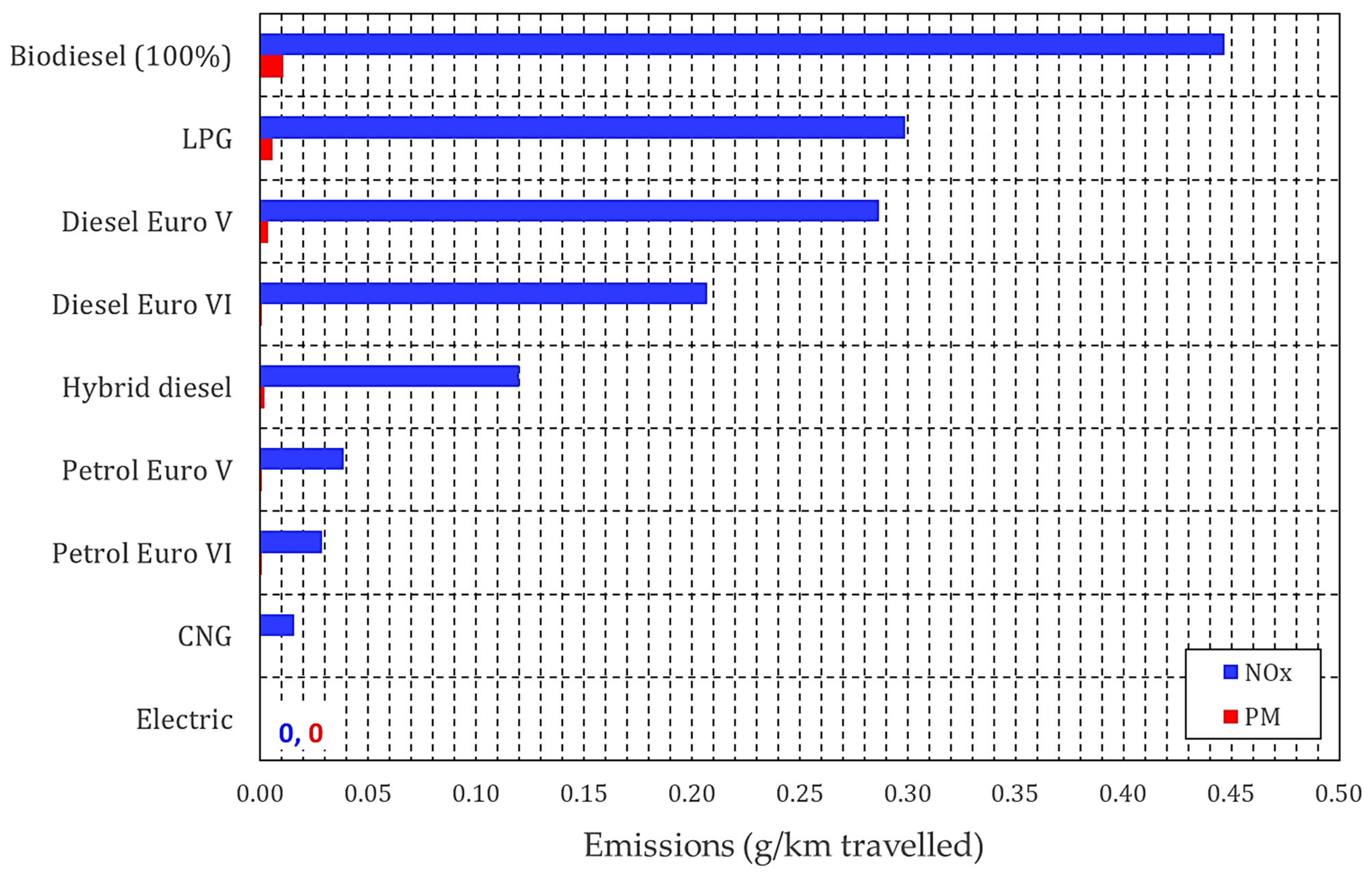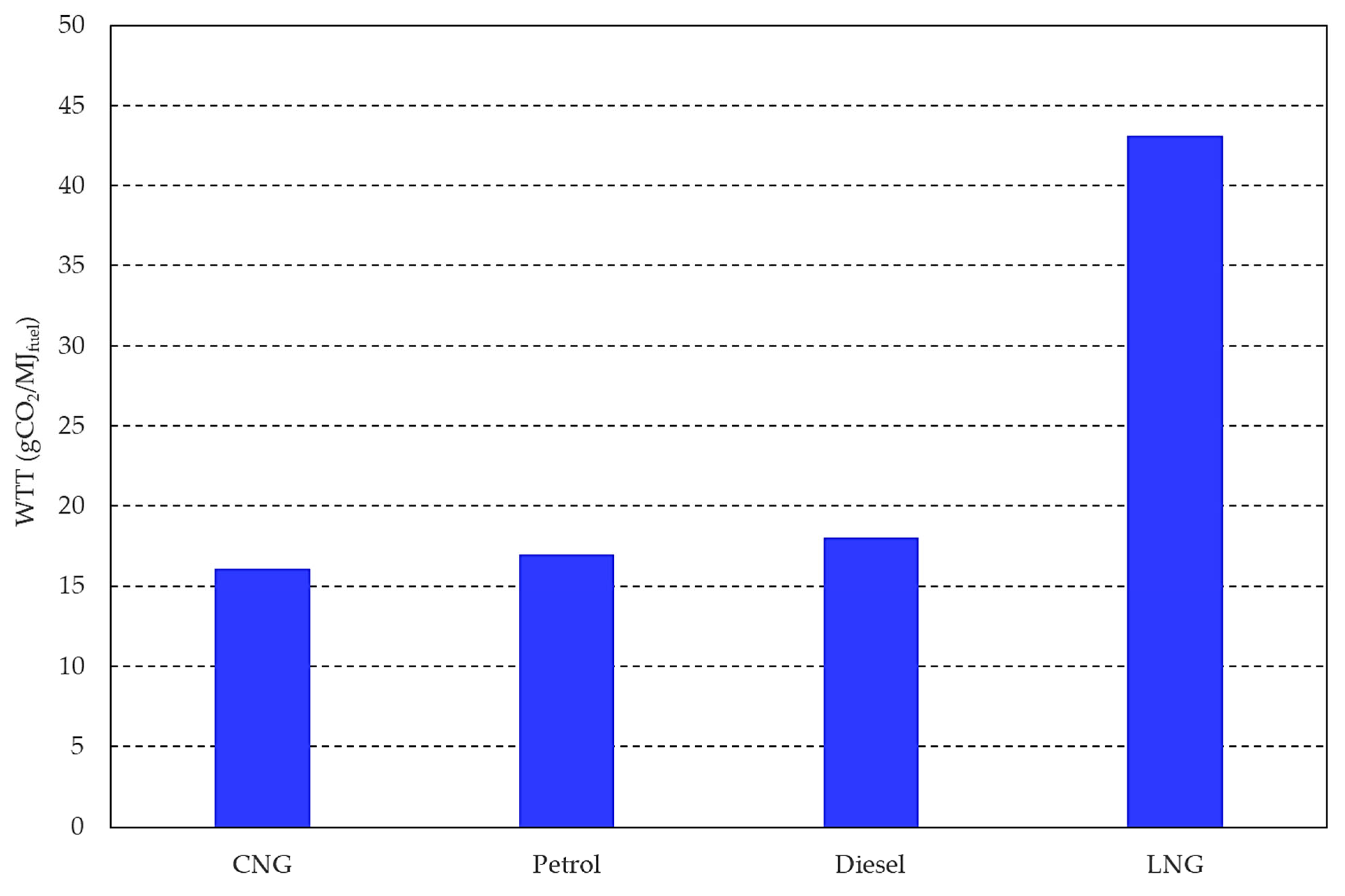Comparative Review of Natural Gas Vehicles During the Energy Transition
Abstract
1. Introduction
2. Overview of Natural Gas Vehicles
3. Comparative Assessment of Environmental Indicators
3.1. NOx and Particulate Emissions
3.2. CO2 Emissions
4. Discussion
4.1. Economic Implications
4.2. Infrastructure Implications
4.3. Emission Implications
4.4. Other Transitional Pathways
4.5. Public Perception and Barriers to NGV Adoption
5. Conclusions
Author Contributions
Funding
Conflicts of Interest
References
- Solomon, B.D.; Krishna, K. The coming sustainable energy transition: History, strategies, and outlook. Energy Policy 2011, 39, 7422–7431. [Google Scholar] [CrossRef]
- Kudasik, M.; Kozieł, K.; Anioł, Ł.; Pajdak, A. Assessment of the Potential for CO2-Enhanced Shale Gas Recovery: Studies on CO2/CH4 Exchange in Shales. Energy Fuels 2025, 39, 11187–11200. [Google Scholar] [CrossRef]
- Li, Y.; Xu, Y. Recent advances in tight oil reservoir development: Integrated technology of horizontal drilling and hydraulic fracturing. Adv. Resour. Res. 2024, 4, 300–317. [Google Scholar] [CrossRef]
- Qadrdan, M.; Johnson, M.R.J.; Mohammed, A.S. A review on hydrogen blending into existing natural gas pipeline infrastructure. Can. J. Chem. Eng. 2021, 99, 359–373. [Google Scholar] [CrossRef]
- Bondarenko, A.V.; Islamov, S.R.; Ignatyev, K.V.; Mardashov, D.V. Laboratory investigation of polymer compositions for well killing in fractured reservoirs. Perm J. Pet. Min. Eng. 2020, 20, 37–48. [Google Scholar] [CrossRef]
- Belousov, A.; Lushpeev, V.; Sokolov, A.; Sultanbekov, R.; Tyan, Y.; Ovchinnikov, E.; Shvets, A.; Bushuev, V.; Islamov, S. Experimental Research of the Possibility of Applying the Hartmann–Sprenger Effect to Regulate the Pressure of Natural Gas in Non-Stationary Conditions. Processes 2025, 13, 1189. [Google Scholar] [CrossRef]
- Thalassinos, E.; Kadłubek, M.; Thong, L.M.; Van Hiep, T.; Ugurlu, E. Managerial Issues Regarding the Role of Natural Gas in the Transition of Energy and the Impact of Natural Gas Consumption on the GDP of Selected Countries. Resources 2022, 11, 42. [Google Scholar] [CrossRef]
- Gillessen, B.; Heinrichs, H.; Hake, J.-F.; Allelein, H.-J. Natural gas as a bridge to sustainability: Infrastructure expansion regarding energy security and system transition. Appl. Energy 2019, 251, 113377. [Google Scholar] [CrossRef]
- GASVESSEL. Natural Gas vs. Coal—A Positive Impact on the Environment. Available online: https://www.gasvessel.eu/news/natural-gas-vs-coal-impact-on-the-environment/ (accessed on 19 March 2025).
- Zhao, S.; Lu, J.; Yan, J.; Wu, H.; Guan, C. Energy transition in China: It is necessary to increase natural gas utilization. Energy Rep. 2023, 10, 2439–2447. [Google Scholar] [CrossRef]
- Reji, A.K.; Das, B.; Ray, T.K.; Boral, E. Assessment of compressed natural gas as an alternative transportation fuel in reducing CO2 emission: A case of Agartala city. Environ. Dev. Sustain. 2025. [Google Scholar] [CrossRef]
- Mądziel, M. Modelling CO2 Emissions from Vehicles Fuelled with Compressed Natural Gas Based on On-Road and Chassis Dynamometer Tests. Energies 2024, 17, 1850. [Google Scholar] [CrossRef]
- International Energy Agency. Global Gas Security Review 2024. 2024. Available online: https://www.iea.org/reports/global-gas-security-review-2024 (accessed on 18 June 2025).
- International Energy Agency. Gas Market Report, Q1-2025. 2025. Available online: https://www.iea.org/reports/gas-market-report-q1-2025/executive-summary (accessed on 18 June 2025).
- Organization of the Petroleum Exporting Countries. Annual Statistical Bulletin 2024. 2024. Available online: https://publications.opec.org/asb/chapter/show/123/2160 (accessed on 18 June 2025).
- Villicaña-García, E.; Ponce-Ortega, J.M. Sustainable strategic planning for a national natural gas energy system accounting for unconventional sources. Energy Convers. Manag. 2019, 181, 382–397. [Google Scholar] [CrossRef]
- Mac Kinnon, M.A.; Brouwer, J.; Samuelsen, S. The role of natural gas and its infrastructure in mitigating greenhouse gas emissions, improving regional air quality, and renewable resource integration. Prog. Energy Combust. Sci. 2018, 64, 62–92. [Google Scholar] [CrossRef]
- Graczyk, A.; Graczyk, A.; Węgrzyn, A. Change in natural gas utilisation in the context of sustainable energy management in Poland. Econ. Environ. 2023, 84, 51–75. [Google Scholar] [CrossRef]
- Ghoneim, S.A.; El-Salamony, R.A.; El-Temtamy, S.A. Review on Innovative Catalytic Reforming of Natural Gas to Syngas. World J. Eng. Technol. 2016, 4, 116–139. [Google Scholar] [CrossRef]
- Khan, M.N.; Cloete, S.; Amini, S. Efficient Production of Clean Power and Hydrogen Through Synergistic Integration of Chemical Looping Combustion and Reforming. Energies 2020, 13, 3443. [Google Scholar] [CrossRef]
- Rodat, S.; Abanades, S. A Hybrid Windowless Dual Tube Solar Reactor for Continuous Volumetric Natural Gas Dissociation. Front. Energy Res. 2020, 8, 206. [Google Scholar] [CrossRef]
- Khan, M.I. Identifying and addressing barriers for the sustainable development of natural gas as automotive fuel. Int. J. Hydrogen Energy 2017, 42, 25453–25473. [Google Scholar] [CrossRef]
- Yeh, S. An empirical analysis on the adoption of alternative fuel vehicles: The case of natural gas vehicles. Energy Policy 2007, 35, 5865–5875. [Google Scholar] [CrossRef]
- US Department of Energy, Alternative Fuels Data Center. Natural Gas Vehicles. Available online: https://afdc.energy.gov/vehicles/natural-gas (accessed on 18 June 2025).
- Khan, M.I. Policy options for the sustainable development of natural gas as transportation fuel. Energy Policy 2017, 110, 126–136. [Google Scholar] [CrossRef]
- Aslam, M.; Masjuki, H.; Kalam, M.; Abdesselam, H.; Mahlia, T.; Amalina, M. An experimental investigation of CNG as an alternative fuel for a retrofitted gasoline vehicle. Fuel 2006, 85, 717–724. [Google Scholar] [CrossRef]
- Sagar, S.; Agarwal, A.K. Experimental validation of accuracy of dynamic hydrogen-compressed natural gas mixing system using a single cylinder spark ignition engine. Int. J. Hydrogen Energy 2016, 41, 14272–14282. [Google Scholar] [CrossRef]
- Chala, G.T.; Aziz, A.R.A.; Hagos, F.Y. Natural Gas Engine Technologies: Challenges and Energy Sustainability Issue. Energies 2018, 11, 2934. [Google Scholar] [CrossRef]
- International Energy Agency. The Contribution of Natural Gas Vehicles to Sustainable Transport. 2010. Available online: https://www.iea.org/reports/the-contribution-of-natural-gas-vehicles-to-sustainable-transport (accessed on 19 March 2025).
- Janssen, A.; Lienin, S.F.; Gassmann, F.; Wokaun, A. Model aided policy development for the market penetration of natural gas vehicles in Switzerland. Transp. Res. Part A Policy Pract. 2006, 40, 316–333. [Google Scholar] [CrossRef]
- Neandross, E. Developments in the U.S. L-NGV Market. In Proceedings of the “LNG is HOT: Opportunities, Challenges & Strategies as a Vehicle Fuel” Conference, Gladstein, Neandross and Associates (GNA), Brussels, Belgium, December 2009. [Google Scholar]
- US Department of Energy, Alternative Fuels Data Center. Fuel Prices, Alterative Fuel Price Report. 2024. Available online: https://afdc.energy.gov/fuels/prices.html (accessed on 24 March 2025).
- International Gas Union. Natural Gas Vehicles: The Sustainable Road Towards a Clean Planet, WOC 5.3—Study Group Report, 2012–2015 Trienniun Work Reports. 2015. Available online: http://members.igu.org/old/IGU%20Events/wgc/wgc-2015/committee-reports-with-thematic-sessions/woc-5-3-paper.pdf (accessed on 18 June 2025).
- Pipeline Technology Journal. India to Expand Natural Gas Pipeline Network by Nearly 11,000 km. 2025. Available online: https://www.pipeline-journal.net/news/india-expand-natural-gas-pipeline-network-nearly-11000-km (accessed on 22 April 2025).
- The State Council, The People’s Republic of China. 2024: China Builds over 4,000 Kilometers of New Oil, Gas Pipelines. 2024. Available online: https://english.www.gov.cn/news/202412/03/content_WS674eb8f7c6d0868f4e8ed9f7.html (accessed on 23 April 2025).
- Khan, M.I.; Yasmeen, T.; Farooq, M.; Wakeel, M. Research progress in the development of natural gas as fuel for road vehicles: A bibliographic review (1991–2016). Renew. Sustain. Energy Rev. 2016, 66, 702–741. [Google Scholar] [CrossRef]
- Liu, L.; Zhang, M.; Liu, Z. A Review of Development of Natural Gas Engines. Int. J. Automot. Manuf. Mater. 2023, 2, 4. [Google Scholar] [CrossRef]
- Poullikkas, A. Sustainable options for electric vehicle technologies. Renew. Sustain. Energy Rev. 2015, 41, 1277–1287. [Google Scholar] [CrossRef]
- Lejda, K.; Jaworski, A.; Mądziel, M.; Balawender, K.; Ustrzycki, A.; Savostin-Kosiak, D. Assessment of Petrol and Natural Gas Vehicle Carbon Oxides Emissions in the Laboratory and On-Road Tests. Energies 2021, 14, 1631. [Google Scholar] [CrossRef]
- Seisler, J.M. Development of the NGV Market and Infrastructure in the US; ABEGAS Brazil Gas Pipeline Association: Rio De Janeiro, Brazil, 2019; Available online: https://www.abegas.org.br/wp-content/uploads/2019/03/04-Development-of-the-NGV-Market-Jeffrey-Seisler-CLEAN-FUELS.pdf (accessed on 18 June 2025).
- Hesterberg, T.W.; Lapin, C.A.; Bunn, W.B. A Comparison of Emissions from Vehicles Fueled with Diesel or Compressed Natural Gas. Environ. Sci. Technol. 2008, 42, 6437–6445. [Google Scholar] [CrossRef]
- Romanyuk, V.; Likhanov, V.; Lopatin, O. Reducing the environmental threat of motor vehicles by converting engines for operating on natural gas. Theor. Appl. Ecol. 2018, 3, 27–32. [Google Scholar] [CrossRef]
- Transport & Environment. Compressed Natural Gas Vehicles Are Not a Clean Solution for Transport. 2020. Available online: https://www.transportenvironment.org/uploads/files/2020_06_TE_CNG_particle_report.pdf (accessed on 18 June 2025).
- Samaras, Z.C.; Andersson, J.; Bergmann, A.; Hausberger, S.; Toumasatos, Z.; Keskinen, J.; Haisch, C.; Kontses, A.; Ntziachristos, L.D.; Landl, L.; et al. Measuring Automotive Exhaust Particles Down to 10 nm. SAE Int. J. Adv. Curr. Pract. Mobil. 2020, 3, 539–550. [Google Scholar] [CrossRef]
- Suarez-Bertoa, R.; Valverde, V.; Clairotte, M.; Pavlovic, J.; Giechaskiel, B.; Franco, V.; Kregar, Z.; Astorga, C. On-road emissions of passenger cars beyond the boundary conditions of the real-driving emissions test. Environ. Res. 2019, 176, 108572. [Google Scholar] [CrossRef] [PubMed]
- Giechaskiel, B.; Lähde, T.; Drossinos, Y. Regulating particle number measurements from the tailpipe of light-duty vehicles: The next step? Environ. Res. 2019, 172, 1–9. [Google Scholar] [CrossRef] [PubMed]
- Giechaskiel, B. Solid Particle Number Emission Factors of Euro VI Heavy-Duty Vehicles on the Road and in the Laboratory. Int. J. Environ. Res. Public Health 2018, 15, 304. [Google Scholar] [CrossRef]
- Suarez-Bertoa, R. Current non-regulated emissions in EU. In Proceedings of the Integer Emissions Summit & AdBlue® Europe 2019, Munich, Germany, 25–27 June 2019. [Google Scholar]
- International Council on Clean Transportation. A Technical Summary of Euro 6/VI Vehicle Emission Standards. 2016. Available online: https://theicct.org/sites/default/files/publications/ICCT_Euro6-VI_briefing_jun2016.pdf (accessed on 16 May 2025).
- ICER Brakes. Normativa Euro 7. 2024. Available online: https://www.icerbrakes.com/en/News/Detail/Normativa-Euro-7 (accessed on 16 May 2025).
- Engerer, H.; Horn, M. Natural gas vehicles: An option for Europe. Energy Policy 2010, 38, 1017–1029. [Google Scholar] [CrossRef]
- PriceWarterhouseCoopers. Impact Assessment on a New Approach for the Cleaner and More Energy Efficient Vehicles Directive Proposal. Final Report to the European Commission. Directorate General Energy and Transport. September 2007. Available online: https://transport.ec.europa.eu/document/download/9241c27e-818e-4edf-b2d9-b0ac14a8286a_en?filename=2007_ia_dir_clean_efficient_vehicles.pdf (accessed on 16 May 2025).
- Spiers, J.; Balcombe, P.; Blomerus, P.; Stettler, M.; Brandon, N.; Hawkes, A. Can Natural Gas Reduce Emissions from Transport? Heavy Goods Vehicles and Shipping; Sustainable Gas Institute, Imperial College London: London, UK, 2019; Available online: https://www.arbitrage-maritime.org/CAMP-V3/fr/Gazette/G49complement/gnl.pdf (accessed on 23 April 2025).
- The Oxford Institute for Energy Studies; Le Fevre, C.N. A Review of Prospects for Natural Gas as a Fuel in Road Transport. 2019. Available online: https://www.oxfordenergy.org/publications/review-prospects-natural-gas-fuel-road-transport/ (accessed on 24 April 2025).
- SNAM. Corporate Responsibility and Social Innovation 2017 Sustainability Report. 2017. Available online: https://reports.snam.it/2017/sustainability-report/servicepages/downloads.html (accessed on 24 April 2025).
- European Environment Agency. CO2 Emissions Performance of New Passenger Cars in Europe. 2024. Available online: https://www.eea.europa.eu/en/analysis/indicators/co2-performance-of-new-passenger#:~:text=For%20the%20years%202020%2D2024,is%20illustrated%20in%20Figure%201 (accessed on 13 May 2025).
- Hagos, D.A.; Ahlgren, E.O. Well-to-wheel assessment of natural gas vehicles and their fuel supply infrastructures—Perspectives on gas in transport in Denmark. Transp. Res. Part D Transp. Environ. 2018, 65, 14–35. [Google Scholar] [CrossRef]
- Joint Research Centre (JRC). Well-to-Wheels Analysis of Future Automotive Fuels and Powertrains in the European Context, Version 4.a. January 2014. Available online: https://publications.jrc.ec.europa.eu/repository/handle/JRC85326 (accessed on 3 June 2025).
- Dulău, L.-I. CO2 Emissions of Battery Electric Vehicles and Hydrogen Fuel Cell Vehicles. Clean Technol. 2023, 5, 696–712. [Google Scholar] [CrossRef]
- Curran, S.J.; Wagner, R.M.; Graves, R.L.; Keller, M.; Green, J.B. Well-to-wheel analysis of direct and indirect use of natural gas in passenger vehicles. Energy 2014, 75, 194–203. [Google Scholar] [CrossRef]
- Halder, P.; Babaie, M.; Salek, F.; Shah, K.; Stevanovic, S.; Bodisco, T.A.; Zare, A. Performance, emissions and economic analyses of hydrogen fuel cell vehicles. Renew. Sustain. Energy Rev. 2024, 199, 114543. [Google Scholar] [CrossRef]
- Hienuki, S.; Mitoma, H.; Ogata, M.; Uchida, I.; Kagawa, S. Environmental and energy life cycle analyses of passenger vehicle systems using fossil fuel-derived hydrogen. Int. J. Hydrogen Energy 2021, 46, 36569–36580. [Google Scholar] [CrossRef]
- Kelly, J.; Elgowainy, A.; Isaac, R.; Ward, J.; Islam, E.; Rousseau, A.; Sutherland, I.; Wallington, T.; Alexander, M.; Muratori, M.; et al. Cradle-to-Grave Lifecycle Analysis of U.S. Light-Duty Vehicle-Fuel Pathways: A Greenhouse Gas Emissions and Economic Assessment of Current (2020) and Future (2030–2035) Technologies. 2023. Available online: https://greet.anl.gov/publication-c2g_lca_us_ldv (accessed on 10 April 2025).
- Tong, F.; Jaramillo, P.; Azevedo, I.M.L. Comparison of Life Cycle Greenhouse Gases from Natural Gas Pathways for Light-Duty Vehicles. Energy Fuels 2015, 29, 6008–6018. [Google Scholar] [CrossRef]
- Tong, F.; Jaramillo, P.; Azevedo, I.M.L. Comparison of Life Cycle Greenhouse Gases from Natural Gas Pathways for Medium and Heavy-Duty Vehicles. Environ. Sci. Technol. 2015, 49, 7123–7133. [Google Scholar] [CrossRef] [PubMed]
- Li, Y.; Taghizadeh-Hesary, F. The economic feasibility of green hydrogen and fuel cell electric vehicles for road transport in China. Energy Policy 2022, 160, 112703. [Google Scholar] [CrossRef]
- Zhang, G.; Zhang, J.; Xie, T. A solution to renewable hydrogen economy for fuel cell buses—A case study for Zhangjiakou in North China. Int. J. Hydrogen Energy 2020, 45, 14603–14613. [Google Scholar] [CrossRef]
- Sharma, A.; Strezov, V. Life cycle environmental and economic impact assessment of alternative transport fuels and power-train technologies. Energy 2017, 133, 1132–1141. [Google Scholar] [CrossRef]
- Huo, H.; Zhang, Q.; Liu, F.; He, K. Climate and Environmental Effects of Electric Vehicles versus Compressed Natural Gas Vehicles in China: A Life-Cycle Analysis at Provincial Level. Environ. Sci. Technol. 2013, 47, 1711–1718. [Google Scholar] [CrossRef]
- EPA. Estimates of Methane Emissions by Segment in the United States. 2025. Available online: https://www.epa.gov/natural-gas-star-program/estimates-methane-emissions-segment-united-states (accessed on 18 June 2025).
- Harris, S.J.; Schwietzke, S.; France, J.L.; Salinas, N.V.; Fernandez, T.M.; Randles, C.; Guanter, L.; Irakulis-Loitxate, I.; Calcan, A.; Aben, I.; et al. Methane emissions from the Nord Stream subsea pipeline leaks. Nature 2025, 637, 1124–1130. [Google Scholar] [CrossRef]
- de Bruin, G.; de Stigter, H.; Diaz, M.; Delre, A.; Velzeboer, I.; Versteijlen, N.; Niemann, H.; Wilpshaar, M.; Reichart, G. Methane leakage from abandoned wells in the Dutch North Sea. Mar. Pet. Geol. 2024, 171, 107184. [Google Scholar] [CrossRef]
- Jia, W.; Jia, P.; Gu, L.; Ren, L.; Zhang, Y.; Chen, H.; Wu, X.; Feng, W.; Cai, J. Quantification of methane emissions from typical natural gas stations using on-site measurement technology. J. Pipeline Sci. Eng. 2025, 5, 100229. [Google Scholar] [CrossRef]
- Weller, Z.D.; Hamburg, S.P.; von Fischer, J.C. A National Estimate of Methane Leakage from Pipeline Mains in Natural Gas Local Distribution Systems. Environ. Sci. Technol. 2020, 54, 8958–8967. [Google Scholar] [CrossRef]
- Jayarathne, J.R.R.N.; Zimmerle, D.; Kolodziej, R.S.; Riddick, S.; Smits, K.M. Flow and Transport of Methane from Leaking Underground Pipelines: Effects of Soil Surface Conditions and Implications for Natural Gas Leak Classification. Environ. Sci. Technol. Lett. 2024, 11, 539–545. [Google Scholar] [CrossRef]
- Schramm, J.; Methane Emission Control (AMF Annex 51). IEA Advanced Motor Fuels Technology Collaboration Programme. 2022. Available online: https://iea-amf.org/app/webroot/files/file/Annex%20Reports/AMF_Annex_51.pdf (accessed on 18 June 2025).
- Alvarez, R.A.; Zavala-Araiza, D.; Lyon, D.R.; Allen, D.T.; Barkley, Z.R.; Brandt, A.R.; Davis, K.J.; Herndon, S.C.; Jacob, D.J.; Karion, A.; et al. Assessment of methane emissions from the U.S. oil and gas supply chain. Science 2018, 361, 186–188. [Google Scholar] [CrossRef] [PubMed]
- Hmiel, B.; Petrenko, V.V.; Dyonisius, M.N.; Buizert, C.; Smith, A.M.; Place, P.F.; Harth, C.; Beaudette, R.; Hua, Q.; Yang, B.; et al. Preindustrial 14CH4 indicates greater anthropogenic fossil CH4 emissions. Nature 2020, 578, 409–412. [Google Scholar] [CrossRef] [PubMed]
- International Energy Agency. Global Methane Tracker 2025. 2025. Available online: https://www.iea.org/reports/global-methane-tracker-2025 (accessed on 18 June 2025).
- The International Council on Clean Transportation. How Upstream Methane Leakage Further Weakens the Argument for Natural Gas Trucks. 2025. Available online: https://theicct.org/how-upstream-methane-leakage-further-weakens-the-argument-for-natural-gas-trucks-jan25/ (accessed on 18 June 2025).
- Energy Education. Natural Gas Vehicle Fuel Storage. 2024. Available online: https://energyeducation.ca/encyclopedia/Natural_gas_vehicle_fuel_storage#cite_ref-3 (accessed on 2 May 2025).
- ET Design & Build. CNG Conversion Costs. Available online: https://etdesignbuild.com/cng-conversion-costs/ (accessed on 2 May 2025).
- Government Fleet, Mika Shelley. Exploring the Total Cost of CNG. 2013. Available online: https://www.government-fleet.com/152764/exploring-the-total-cost-of-cng (accessed on 2 July 2025).
- Zito, P.; Salerno, S.; Potential Demand and Cost-Benefit Analysis of Electric Cars. European Transport/Trasporti Europei, ISTIEE, Institute for the Study of Transport within the European Economic Integration. 2004, Volume 27, pp. 1–14. Available online: http://hdl.handle.net/10077/5842 (accessed on 2 May 2025).
- van den Bulk, J. A Cost- and Benefit Analysis of Combustion Cars, Electric Cars and Hydrogen Cars in The Netherlands; Wageningen UR: Wageningen, The Netherlands, 2009; Available online: https://refman.energytransitionmodel.com/publications/1930 (accessed on 2 May 2025).
- Creti, A.; Kotelnikova, A.; Meunier, G.; Ponssard, J.P. A Cost Benefit Analysis of Fuel Cell Electric Vehicles. 2015. Available online: https://hal.science/hal-01116997v1 (accessed on 2 May 2025).
- Smith, M.; John Gonzales, J. Costs Associated with Compressed Natural Gas Vehicle Fuelling Infrastructure; US Department of Energy: Washington, DC, USA, 2014. Available online: http://www.afdc.energy.gov/uploads/publication/cng_infrastructure_costs.pdf (accessed on 2 May 2025).
- Mitchell, G. Building a Business Case for Compressed Natural Gas in Fleet Applications; National Renewable Energy Laboratory, U.S. Department of Energy: Golden, CO, USA, 2015. Available online: http://www.nrel.gov/docs/fy15osti/63707.pdf (accessed on 2 May 2025).
- IEA. Global EV Outlook 2023; IEA: Paris, France, 2023; Available online: https://www.iea.org/reports/global-ev-outlook-2023 (accessed on 19 June 2025).
- EV Boosters. The State of Public EV Charging: China, Europe, and U.S. Compared. 2024. Available online: https://evboosters.com/ev-charging-news/the-state-of-public-ev-charging-china-europe-and-u-s-compared/ (accessed on 19 June 2025).
- Ludwig-Bölkow-Systemtechnik (LBST); TÜV SÜD. Milestone Reached: Over 1000 Hydrogen Refuelling Stations in Operation Worldwide in 2024. 2025. Available online: https://www.tuvsud.com/-/jssmedia/global/pdf-files/press-and-media/2025/february/022b_lbst_hydrogen-refuelling-stations_statistik_en.pdf (accessed on 19 June 2025).
- U.S. Department of Energy. DOE Hydrogen Program Record 21002: Hydrogen Fueling Stations Cost. 2021. Available online: https://www.hydrogen.energy.gov/docs/hydrogenprogramlibraries/pdfs/21002-hydrogen-fueling-station-cost.pdf?Status=Master (accessed on 19 June 2025).
- Prokopou, G.I.; Faust, J.M.; Mitsos, A.; Bongartz, D. Cost-optimal design and operation of hydrogen refueling stations with mechanical and electrochemical hydrogen compressors. Comput. Chem. Eng. 2024, 192, 108862. [Google Scholar] [CrossRef]
- Wu, L.; Zhu, Z.; Feng, Y.; Tan, W. Economic analysis of hydrogen refueling station considering different operation modes. Int. J. Hydrogen Energy 2023, 52, 1577–1591. [Google Scholar] [CrossRef]
- von Rosenstiel, D.P.; Heuermann, D.F.; Hüsig, S. Why has the introduction of natural gas vehicles failed in Germany?—Lessons on the role of market failure in markets for alternative fuel vehicles. Energy Policy 2015, 78, 91–101. [Google Scholar] [CrossRef]
- Chaudhury, A. Running Out of Gas? Lessons from the Natural Gas Vehicles (NGV) Market in Pakistan. 2013. Available online: https://papers.ssrn.com/sol3/papers.cfm?abstract_id=2391524 (accessed on 2 July 2025).
- Shaarawi, S.I.; Abutaleb, K.; Aboelmagd, A.R.; Temraz, T. Reviewing Natural Gas Vehicle Fleet Growth in Egypt: A Study of Environmentally Friendly Transportation Fuel. Egypt. J. Pet. 2024, 33, 3. [Google Scholar] [CrossRef]
- Christou, M.; UN Habitat. For a Better Urban Future. Available online: https://unhabitat.org/sites/default/files/download-manager-files/Module%206%20-%20Annexure%20E%20case%20study%20Cairo.pdf (accessed on 2 May 2025).
- IHS Cera. Global Insight, Report; IHS Cera: Cambridge, MA, USA, 2010. [Google Scholar]
- Cooper, J.; Balcombe, P.; Hawkes, A. The quantification of methane emissions and assessment of emissions data for the largest natural gas supply chains. J. Clean. Prod. 2021, 320, 128856. [Google Scholar] [CrossRef]
- United Nations Environment Programme. Methane Emissions Tracking System Proves Its Worth, but Action to Plug Leaks Must Accelerate. 2024. Available online: https://www.unep.org/news-and-stories/press-release/methane-emissions-tracking-system-proves-its-worth-action-plug-leaks (accessed on 19 June 2025).
- Gontaruk, Y.; Kolomiiets, T.; Honcharuk, I.; Tokarchuk, D. Production and Use of Biogas and Biomethane from Waste for Climate Neutrality and Development of Green Economy. J. Ecol. Eng. 2024, 25, 20–32. [Google Scholar] [CrossRef]
- Harrison, A.; Watson, M.D.; Dodds, P.E.; Brandon, N.P. Hydrogen blending and utilisation within the European gas grid—A critical review. Int. J. Hydrogen Energy 2021, 46, 27807–27827. [Google Scholar] [CrossRef]
- Shinde, A.M.; Dikshit, A.K.; Odlare, M.; Thorin, E.; Schwede, S. Life cycle assessment of bio-methane and biogas-based electricity production from organic waste for utilization as a vehicle fuel. Clean Technol. Environ. Policy 2021, 23, 1715–1725. [Google Scholar] [CrossRef]
- European Biogas Association. Biomethane as a Solution for Heavy-Duty Transport Decarbonization (EBA Policy Recommendations on the Revised CO2 Emission Standards for HDVs). 2023. Available online: https://www.europeanbiogas.eu/wp-content/uploads/2023/01/EBA-Policy-Paper-on-CO2-standards-for-HDVs.pdf (accessed on 19 June 2025).
- European Biogas Association. SMART CO2 STANDARDS FOR NEGATIVE EMISSIONS MOBILITY. 2021. Available online: https://www.europeanbiogas.eu/wp-content/uploads/2021/06/SMART-CO2-STANDARDS-FOR-NEGATIVE-EMISSIONS-MOBILITY.pdf (accessed on 19 June 2025).
- IEA. Energy Policy Review; IEA: Paris, France, 2024. [Google Scholar]
- BioEnergy International; Sherrard, A. Biomethane Reaches 90% Share in Swedish Vehicle Gas. 2018. Available online: https://bioenergyinternational.com/biomethane-reaches-90-share-in-swedish-vehicle-gas/ (accessed on 5 May 2025).
- IEA. Bioenergy Task 37, 100% Biogas for Urban Transport in Linköping, Sweden. Available online: https://www.iea-biogas.net/_download/linkoping_final.pdf (accessed on 5 May 2025).
- BioGas Partner. Available online: https://www.dena.de/en/biogaspartner/ (accessed on 5 May 2025).
- Makaryan, I.A.; Sedov, I.V.; Salgansky, E.A.; Arutyunov, A.V.; Arutyunov, V.S. A Comprehensive Review on the Prospects of Using Hydrogen–Methane Blends: Challenges and Opportunities. Energies 2022, 15, 2265. [Google Scholar] [CrossRef]
- McTaggart-Cowan, G.P.; Munshi, S.R.; Rogak, S.N.; Hill, P.G.; Bushe, W.K. Hydrogen-Methane Blend Fuelling of a Heavy-Duty, Direct-Injection Engine. In Proceedings of the IMECE2007 ASME International Mechanical Engineering Congress and Exposition, Seattle, WA, USA, 11–15 November 2007. [Google Scholar]
- McTaggart-Cowan, G.; Jones, H.; Rogak, S.; Bushe, W.; Hill, P.; Munshi, S. Direct-Injected Hydrogen-Methane Mixtures in a Heavy-Duty Compression Ignition Engine. In Proceedings of the SAE 2006 World Congress & Exhibition, Detroit, MI, USA, 3–6 April 2006. [Google Scholar] [CrossRef]
- De Simio, L.; Iannaccone, S.; Guido, C.; Napolitano, P.; Maiello, A. Natural Gas/Hydrogen blends for heavy-duty spark ignition engines: Performance and emissions analysis. Int. J. Hydrogen Energy 2023, 50, 743–757. [Google Scholar] [CrossRef]
- Mariani, A.; Morrone, B.; Unich, A. A Review of Hydrogen-Natural Gas Blend Fuels in Internal Combustion Engines, Fossil Fuel and Environment; InTech: Shanghai, China, 2012. [Google Scholar] [CrossRef]
- Pan, H.; Geng, S.; Yang, H.; Zhang, G.; Bian, H.; Liu, Y. Influence of H2 blending on NOx production in natural gas combustion: Mechanism comparison and reaction routes. Int. J. Hydrogen Energy 2022, 48, 784–797. [Google Scholar] [CrossRef]
- European Commission LIFE Public Database. Methane and Hydrogen Blend for Public City Transport Bus: Technical Demonstrative Application and Strategic Policy Measures. 2013. Available online: https://webgate.ec.europa.eu/life/publicWebsite/project/LIFE07-ENV-IT-000434/methane-and-hydrogen-blend-for-public-city-transport-bus-technical-demonstrative-application-and-strategic-policy-measures# (accessed on 5 May 2025).
- Frontier Group, Global Warming Solutions. Blending Hydrogen with Methane Gas is Not a Climate Solution. 2024. Available online: https://frontiergroup.org/articles/blending-hydrogen-with-methane-gas-is-not-a-climate-solution/ (accessed on 5 May 2025).
- Zhang, G.; Liu, J.; Xu, Y.; Sun, Y. A review of CH4CO2 reforming to synthesis gas over Ni-based catalysts in recent years (2010–2017). Int. J. Hydrogen Energy 2018, 43, 15030–15054. [Google Scholar] [CrossRef]
- Mohanty, U.S.; Ali, M.; Azhar, M.R.; Al-Yaseri, A.; Keshavarz, A.; Iglauer, S. Current advances in syngas (CO + H2) production through bi-reforming of methane using various catalysts: A review. Int. J. Hydrogen Energy 2021, 46, 32809–32845. [Google Scholar] [CrossRef]
- Molburg, J.C.; Doctor, R.D. Hydrogen from steam-methane reforming with CO2 capture. In Proceedings of the 20th Annual International Pittsburgh Coal Conference, Pittsburgh, PA, USA, 15–19 September 2003; Volume 20, pp. 1–20. [Google Scholar]
- Islam, A.; Alam, T.; Sheibley, N.; Edmonson, K.; Burns, D.; Hernandez, M. Hydrogen blending in natural gas pipelines: A comprehensive review of material compatibility and safety considerations. Int. J. Hydrogen Energy 2024, 93, 1429–1461. [Google Scholar] [CrossRef]
- Kanellopoulos, K.; Busch, S.; De Felice, M.; Giaccaria, S.; Costescu, A. Blending Hydrogen from Electrolysis into the European Gas Grid; EUR 30951 EN; Publications Office of the European Union: Luxembourg, 2022. [Google Scholar] [CrossRef]
- American Gas Association. Impacts of Hydrogen Blending on Gas Piping Materials. 2023. Available online: https://www.aga.org/wp-content/uploads/2023/08/Impacts-of-Hydrogen-Blending-on-Gas-Piping-Ma_.pdf (accessed on 19 June 2025).
- Topolski, K.; Reznicek, E.P.; Erdener, B.C.; San Marchi, C.W.; Ronevich, J.A.; Fring, L.; Simmons, K.; Fernandez, O.J.G.; Hodge, B.; Chung, M. Hydrogen Blending into Natural Gas Pipeline Infrastructure: Review of the State of Technology; National Renewable Energy Laboratory: Golden, CO, USA, 2022. Available online: https://docs.nrel.gov/docs/fy23osti/81704.pdf (accessed on 19 June 2025).
- Erdener, B.C.; Sergi, B.; Guerra, O.J.; Chueca, A.L.; Pambour, K.; Brancucci, C.; Hodge, B.-M. A review of technical and regulatory limits for hydrogen blending in natural gas pipelines. Int. J. Hydrogen Energy 2022, 48, 5595–5617. [Google Scholar] [CrossRef]
- Huang, H.; Li, J.; Sun, X.; Yu, B.; Zhang, W.; Ma, L. Influence analysis on the storage capacity of hydrogen-blended natural gas pipeline. Comput. Energy Sci. 2024, 1, 3–16. [Google Scholar] [CrossRef]
- Reza, A.; Buehler, C.; Carnahan, R.; Ott, B. Exponent: “Can Your Natural Gas Pipelines Handle Hydrogen Blends?” 2022. Available online: https://www.exponent.com/article/can-your-natural-gas-pipelines-handle-hydrogen-blends (accessed on 19 June 2025).
- First Gas. Te Horo Hydrogen Blend Project. Available online: https://firstgas.co.nz/te-horo-hydrogen-blend-project (accessed on 19 June 2025).
- Energy Capital Ventures. Hydrogen Blending: Advancing Green Molecules™ Through Natural Gas. Available online: https://www.energycapitalventures.com/post/hydrogen-blending-advancing-green-molecules-tm-through-natural-gas (accessed on 19 June 2025).
- Rinnovabili.it. Italy Tests Hydrogen-Gas Blend in Its Pipeline Network. 2025. Available online: https://www.rinnovabili.net/tech-innovations-and-startups/energy-tech-innovations-and-startups/hydrogen-gas-blend-italy-launches-5-test-in-gas-network/ (accessed on 19 June 2025).
- Dougherty, S.; Nigro, N. Alternative Fuel Vehicle & Fueling Infrastructure Deployment Barriers & the Potential Role of Private Sector Financial Solutions; Center for Climate and Energy Solutions, US Department of Energy: Washington, DC, USA, 2014. Available online: http://www.afdc.energy.gov/uploads/publication/afv_fueling_infrastructure_deployment_barriers.pdf (accessed on 19 June 2025).
- Kilbourne, W.; Pickett, G. How materialism affects environmental beliefs, concern, and environmentally responsible behavior. J. Bus. Res. 2008, 61, 885–893. [Google Scholar] [CrossRef]

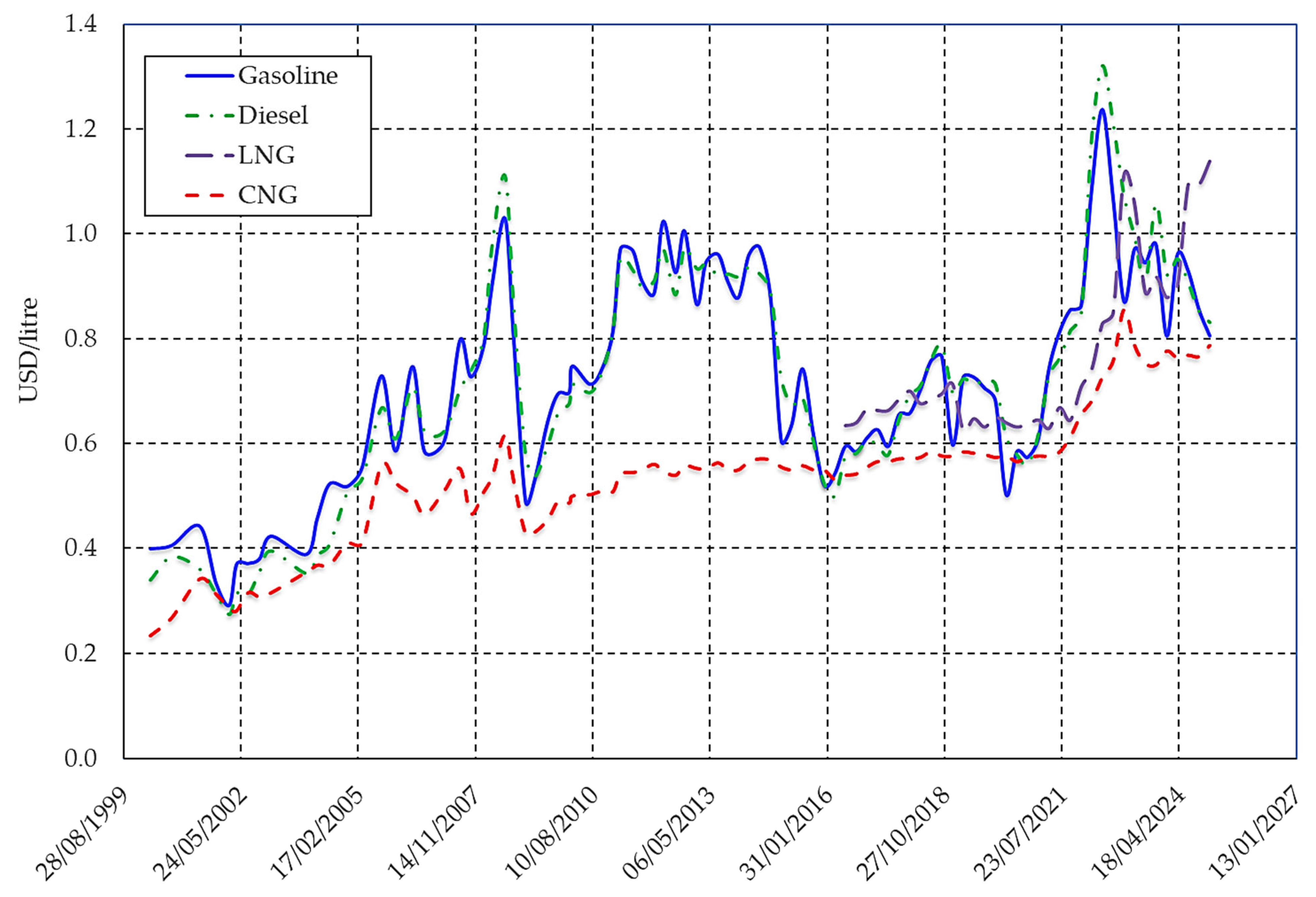
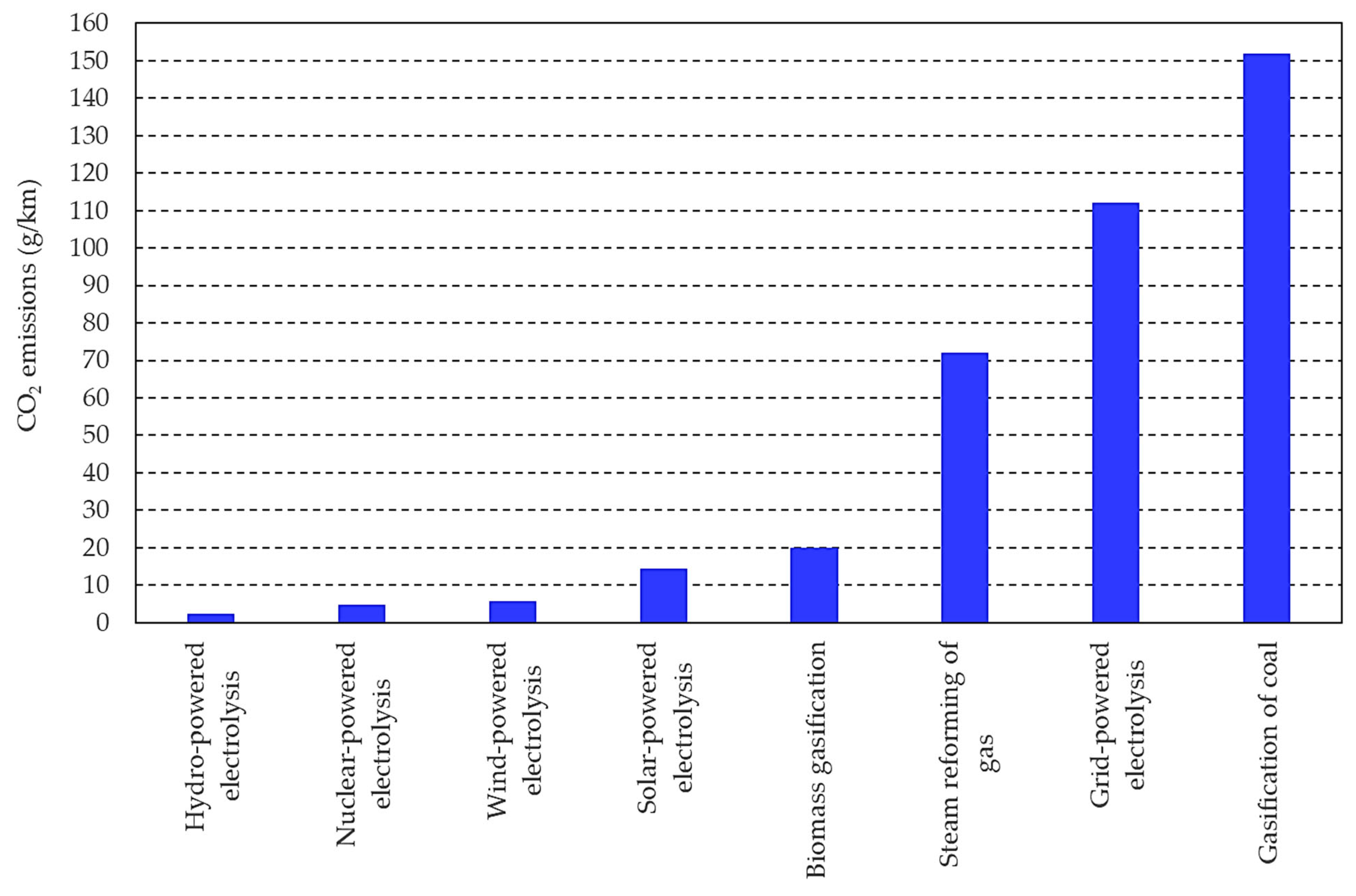

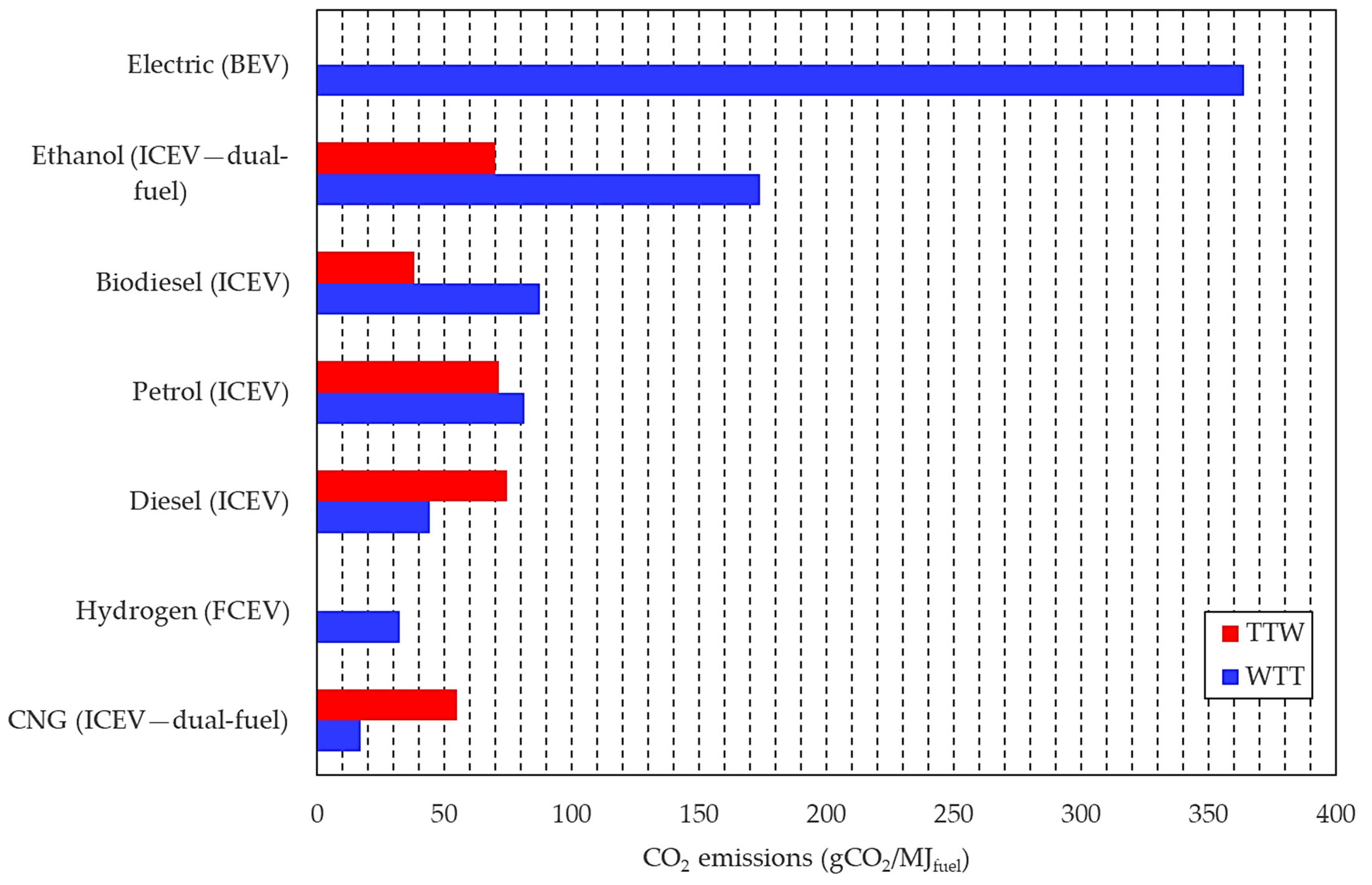
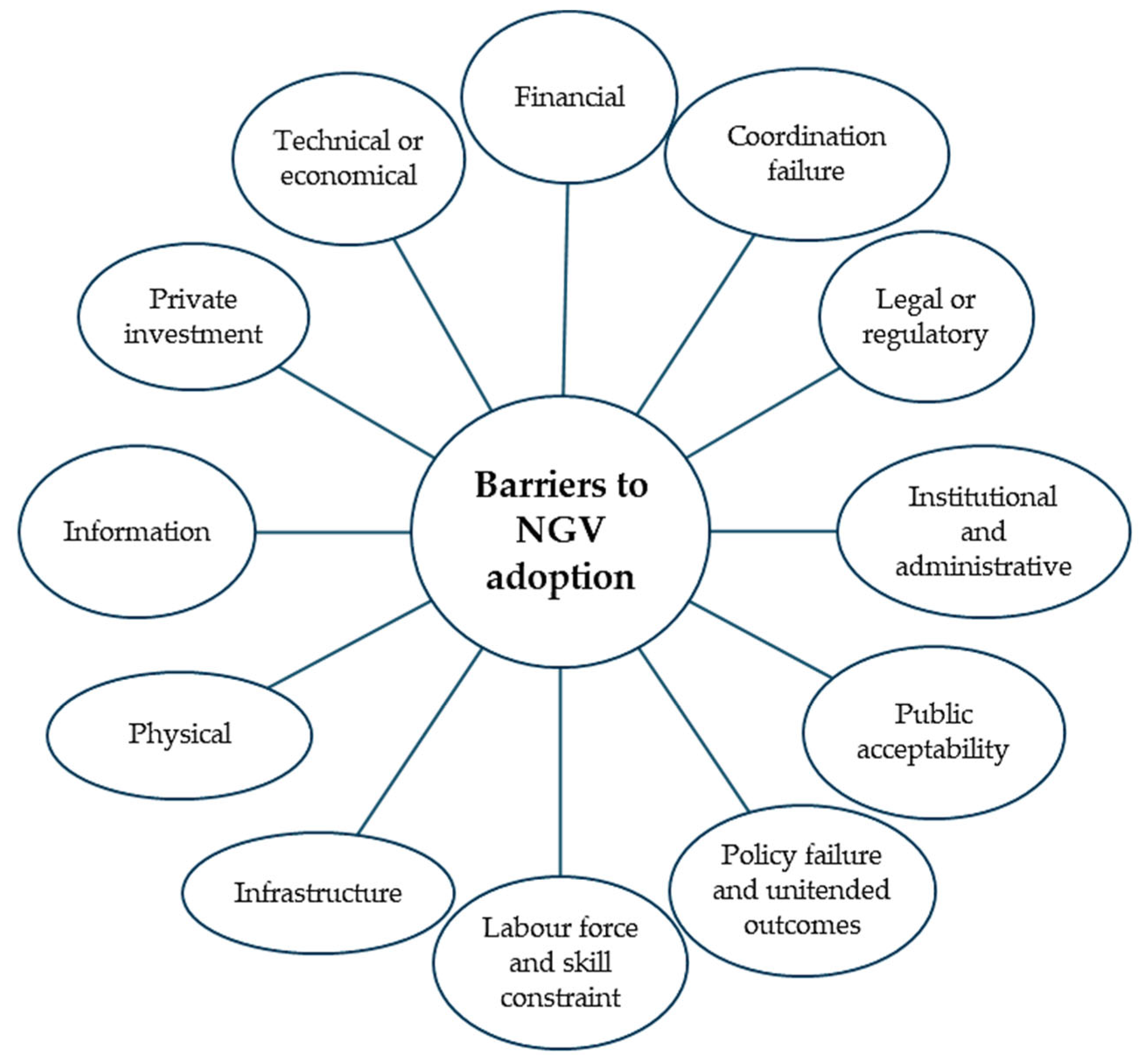
| Fuel Type | Engine Specifications | Comments |
|---|---|---|
| CNG (compressed natural gas) | Spark-ignition combustion, similar to petrol engines | CNG is stored in tank and transferred to the engine through a pressure regulator to adjust pressure. Fuel is combined with air, and the air/fuel mixture is ignited by a spark from a spark plug. Some HDVs that use CNG have a diesel-like compression–injection system. |
| LNG (liquefied natural gas) | Spark-ignition combustion, similar to petrol engines | The natural gas is super-cooled and cryogenically stored in liquid form, usually in a tank on the side of the truck. As it is stored as a liquid, the energy density of LNG is greater than CNG, so more fuel can be stored on board the vehicle, making it suitable for HDVs travelling long distances. The use of LNG is more complicated than CNG, and thus, it is only used in some HDVs to meet longer range requirements. |
| Bi-fuel (petrol or CNG) | Spark-ignition combustion, similar to petrol engines | The vehicle can use either petrol or CNG in the same internal combustion engine. Both fuels are stored on board, and the driver can switch between the fuels. The vehicle is equipped with separate fuel tanks, fuel injection systems, and fuel lines for both fuels. |
| Dual-fuel (CNG and diesel blend) | Internal combustion engine, similar to diesel engines | A blend of the fuels is used in order to assist ignition (even as low as 90% CNG, 10% diesel). This configuration is traditionally limited to HDVs. |
| Country | Number of Fuelling Stations |
|---|---|
| China | 8400 |
| Pakistan | 3416 |
| Iran | 2400 |
| Argentina | 2014 |
| Brazil | 1805 |
| India | 1424 |
| Italy | 1219 |
| Vehicle Type | Internal Combustion Engine | Battery Charging |
|---|---|---|
| Hybrid Electric Vehicle (HEV) | Yes | On-board (internal) |
| Plug-In Electric Vehicle (PHEV) | Yes | On-board (internal) and/or external charging |
| Full Electric Vehicle (or Battery Electric Vehicle, BEV) | No | External Charging |
| Fuel Cell Electric Vehicle (FCEV) using H2 | No | On-board (internal) |
| Vehicle Type | Regulated Emissions | Unregulated Emissions | Comments |
|---|---|---|---|
| LDV—Petrol | Carbon Monoxide (CO) = 1.0 g/km Nitrogen Oxides (NOx) = 0.06 g/km Total Hydrocarbons (HCs) = 0.10 g/km Particulate Matter (PM) = 0.005 g/km Particulate Number (PN) = 6 × 1011/km | Nitrous oxide (N2O), ammonia (NH3), and ultrafine particles (which may be partially regulated via PN, but smaller fractions are still of concern). | PM limits for gasoline are newer, primarily for direct injection engines. |
| LDV—Diesel | CO = 0.50 g/km NOx = 0.08 g/km HC + NOx = 0.17 g/km PM = 0.005 g/km PN = 6 × 1011/km | N2O, NH3, Sulphur Dioxide (SO2) and ultrafine particles (which may be partially regulated via PN, but smaller fractions are still of concern). | Diesel vehicles have historically faced stricter PM limits. |
| HDV—Diesel | CO = 4 g/km NOx = 0.46 g/km HC = 0.16 g/km PM = 0.01 g/km PN = 8 × 1011/km SO2 = 10 ppm NH3 = 0.0045 g/km | N2O, ultrafine particles (which may be partially regulated via PN, but smaller fractions are still of concern), metals (from engine wear/lube oil). | HDVs often have distinct and generally stricter limits because of their higher fuel consumption and mileage. They are also differentiated between steady-state and transient testing. Here, maximum values are given. |
| EV | Hybrids: When operating via an internal combustion engine (ICE). Same as comparable petrol/diesel ICE vehicles (CO, NOx, PM, PN). | When operating via an ICE: same as comparable petrol/diesel ICE vehicles (NH3, N2O), SO2, ultrafine particles. | PHEVs have zero emissions when running purely on electricity. BEVs produce no tailpipe emissions. |
| NGV | Same as comparable diesel/petrol vehicles (CO, NOx, PM, PN). | Same as comparable petrol/diesel ICE vehicles (NH3, N2O), SO2, ultrafine particles, CH4. | While not a direct tailpipe limit, methane slip due to uncombusted natural gas is an issue. |
| Fuel | WTT CO2 Emissions (gCO2/MJfuel) |
|---|---|
| Petrol | 12.5 |
| Diesel | 14.2 |
| CNG | 8.4 |
| CNG transported over 4000 km | 14.0 |
| CNG transported over 7000 km | 21.7 |
| NGVs | EVs | H2 FCEV | |
|---|---|---|---|
| Costs | Purchasing price of LDVs: EUR 2000 higher, MD/HDVs: 50% higher than its conventional vehicle price. Retrofitted engines on existing cars add around USD 6000–USD 13,000 to the price for LDVs [81] and USD 15,000 for HDVs. [22,82,83]. Running costs are seen to be lower because of lower fuel costs, even though they fluctuate [32,83]. Unexpected costs, including maintenance facility upgrades, technician training, fuelling facility maintenance, etc., come to the investor or government (if public-owned) [83]. | Purchasing price: The price of EVs is around 2–2.5 times higher than the price of conventional-fuelled vehicles [84]. Battery costs are the most significant parameter contributing to the higher prices of EVs, as well as maintenance costs [38]. Running costs can be lower because of the lower prices of electricity (depending on the source) and higher diesel/petrol prices due to taxation [84]. Also, fewer moving parts means less wear and tear (e.g., no oil and filter replacements), thus maintenance can be reduced to once per 40,000 km instead of around 6000 km [85]. | Highest purchasing costs in comparison to all the other examined vehicles. Purchasing price projected to fall between USD 20,000 and USD 25,000 in 2050 [85,86]. Running costs are higher because of the higher price of hydrogen [86]. |
| CO2 Emission reductions | WTW: On average, 25% reductions [29]. WTT: Similar, but ultimately depends on the pathways followed by natural gas (CNG vs. LNG, transport distances, grid availability, etc.) [69,81]. TTW: Lower, as natural gas emits less CO2 [39,68,86]. | WTW: Depending on the vehicle, 0.5–0.8 times the conventional emissions [60,63,64,65]. WTT: Depend on the source of electricity; they can be close to conventional fuels when electricity is sourced from fossil fuels [38,59,68]. TTW: Significantly less even for hybrids (0.6–0.7 times the conventional) and zero for BEVs. | WTW: Less, as there are no TTW emissions; depend on the source of hydrogen [59]. WTT: Depending on the source of hydrogen, 0.4–0.7 times the conventional [59,63,66,68]. TTW: Zero. |
| Infrastructure readiness | NGV refuelling stations can be costly (USD 1.2 to 1.8 million) [22,87,88], so modular additions to existing refuelling stations can allow for grid expansion. The existing natural grid can be leveraged to supply the refuelling stations. | EV infrastructure is rapidly evolving (55% increase from 2021 to 2022), but unevenly (China leads in the number of charging points) [89,90]. | Lack of robust refuelling network. Around 1160 stations worldwide, with Asia leading the deployment [91]. High capital costs of stations (~USD 1.9 million) [92] that vary with configuration and operation modes [93,94]. |
| Maturity | Highly mature engine technology, especially for bi-/dual-fuel engines. | Highly mature engine technology. | Significantly less mature than NGVs and EVs. |
Disclaimer/Publisher’s Note: The statements, opinions and data contained in all publications are solely those of the individual author(s) and contributor(s) and not of MDPI and/or the editor(s). MDPI and/or the editor(s) disclaim responsibility for any injury to people or property resulting from any ideas, methods, instructions or products referred to in the content. |
© 2025 by the authors. Licensee MDPI, Basel, Switzerland. This article is an open access article distributed under the terms and conditions of the Creative Commons Attribution (CC BY) license (https://creativecommons.org/licenses/by/4.0/).
Share and Cite
Himona, E.; Poullikkas, A. Comparative Review of Natural Gas Vehicles During the Energy Transition. Energies 2025, 18, 3512. https://doi.org/10.3390/en18133512
Himona E, Poullikkas A. Comparative Review of Natural Gas Vehicles During the Energy Transition. Energies. 2025; 18(13):3512. https://doi.org/10.3390/en18133512
Chicago/Turabian StyleHimona, Eleni, and Andreas Poullikkas. 2025. "Comparative Review of Natural Gas Vehicles During the Energy Transition" Energies 18, no. 13: 3512. https://doi.org/10.3390/en18133512
APA StyleHimona, E., & Poullikkas, A. (2025). Comparative Review of Natural Gas Vehicles During the Energy Transition. Energies, 18(13), 3512. https://doi.org/10.3390/en18133512





